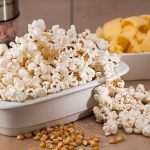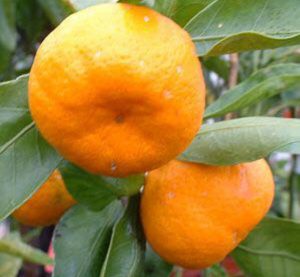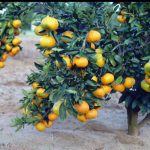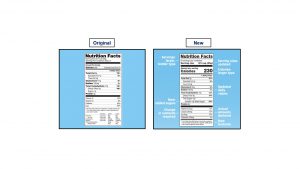by Laurie Osgood | Feb 14, 2017
February has been designated National Snack Month by the Snack Food Association of America, and the National Potato Promotion Board.
As Americans, the one thing that we can all agree on is our love of snacks. Snack sales in the United States top $60 Billion annually. The snack foods that we tend to reach for can be loaded with calories, sugar, sodium and fat. However, snack foods do not have to be unhealthy to satisfy your cravings. When you need a little boost of energy during the day, a healthy snack can do the trick.
According to University of Florida’s Karla Shelnutt, Associate Professor and Extension Nutrition Specialist, and Julie Martinez, healthy snacking is an important part of a child’s daily intake. The key is to learn how to make healthy snack choices and to avoid consuming too many snacks high in sugar and salt, and low in healthy nutrients (http://edis.ifas.ufl.edu/topic_snacks ).
The key to healthy snacking is to plan ahead. Keep a variety of tasty, healthy snacks on hand to help to tide your family over in between meals. When shopping for your family, remember to select healthier items such as fresh fruits and vegetables and make sure to read food labels when selecting pre-packaged snacks.
Additional healthy snacking ideas:
- Cut back on the high-calorie snacks. Choose fruits, vegetables and whole grains, like popcorn.

- Snack when you are hungry, not when your are bored or stressed. Know the difference!
- Eat sensible portion sizes; use single serve containers for snacks.
- Quench your thirst with water, instead of high sugar drinks.
Healthy snack suggestions:
- Ants on a log — Peanut butter filled celery sticks, topped with raisins.
- Healthy ice pops — Pour 100% juice into ice cube trays and freeze.
- Slices of apple with peanut butter
- Smoothies with fat-free milk and frozen strawberries
- Yogurt and fresh fruit
- Crackers and cheese sticks
For more information on the importance of healthy snacking, contact your Family and Consumer Science Agent at your local UF/IFAS Extension Office.
Sources:
Raising Healthy Children: The Role of Snacking. Julie M. Martinez and Karla P. Shelnutt. UF/IFAS EDIS, FCS8902/FY1154. http://edis.ifas.ufl.edu/topic_snacks
Academy of Nutrition and Dietetics. http://www.eatrightpro.org/resource/media/press-releases/national-nutrition-month/during-nnm-make-sensible-snacks-part-of-your-healthy-eating-planpro-press-release
by Laurie Osgood | Jan 27, 2017
It’s that time of year again – time to make resolutions designed to improve your life to become a happier, healthier, and wealthier person. Unfortunately, some resolutions are not realistic and set us up for failure from the start. A very small percentage of us manage to maintain these lofty resolutions.
However, there are small changes you can make today that can help you enjoy a healthy lifestyle. You can start by simply reading the nutrition fact labels on your favorite foods. Smart dietary choices include eliminating or cutting back on these 5 commonly used food items.

- Added Sugar: Some foods, such as milk (lactose) and fruits (fructose), naturally contain sugars. Added sugars (like sucrose and high fructose corn syrup) are added to prepared foods and drinks. Many prepared and processed foods are stocked with added or refined sugars for supplemental sweetness. Added sugars are often called “empty” calories, because they contain extra calories and few or no vitamins and minerals, and can lead to extra pounds or even obesity, thereby reducing heart health. Alternatives: Instead of eating foods with a lot of added sugar, try a piece of fruit or use other options such as raw honey, Stevia or maple syrup.
- Sodium: is found in many processed foods, and is commonly known as salt. Excess sodium increases blood pressure because it holds excess fluid in the body, and that creates an added burden on the heart. Too much sodium will increase your risk of stroke, heart failure, osteoporosis, and some cancers. Alternatives: You can reduce the amount of sodium in your diet by limiting the amount of salt you add to your foods, avoiding processed foods, and by choosing “reduced sodium,” “no sodium added,” or “low sodium” options when available. Try experimenting with fresh or dried herbs/seasonings to flavor to foods without adding salt.
- Enriched Flour: this ingredient is included in many of the processed foods that we eat including pasta, cereals and breads. Whole grain flours are often stripped of their nutrients. Then, to be considered enriched, vitamins, sugar, and other additives are added back in. Alternatives: Instead of white bread, pasta or rice, choose whole grain products instead.
- Saturated Animal Fats: this type of fact, in the form of lard, butter, eggs, cheese, and tallow come primarily from animals and are known to cause health issues such as high cholesterol and heart disease. Minimizing intake of unhealthy fats allows you to reduce calorie intake in a healthy manner. Unsaturated fats offer important health benefits and should be included in everyone’s diet. Alternatives: A simple alternative to saturated fats in your diet can be unsaturated fats found in non-animal, plant products such as fruits & vegetables, oils, nuts and seeds.
- Hydrogenated Oils; commonly called Trans fats, or Trans Fatty Acids. Hydrogenation is the process of converting a pourable oil into a more solid, saturated fat, and is often added to a product in order to extend its shelf life. Partially or fully hydrogenated oils promote cardiovascular diseases by raising your bad (LDL) cholesterol levels and lowering your good (HDL) cholesterol levels. Alternatives: Choose oils that are high in polyunsaturated and monounsaturated fat, such as olive, safflower and peanut oils. Another healthy alternative to hydrogenated oil is Omega- 3 oils from fish. Also, try broiling foods instead of frying.
Overly ambitious New Year’s Resolutions often fail because they require major changes in a very short amount of time, making them almost impossible to stick with. Instead of broad, life changing goals, your New Year’s Resolution should include small lifestyle changes, such as starting with cutting back on or eliminating these 5 items.
Resources:
University of Florida IFAS Extension;
http://edis.ifas.ufl.edu/fy1400
American Heart Association:
http://www.heart.org/HEARTORG/HealthyLiving/HealthyEating/Nutrition/Added-Sugars_UCM_305858_Article.jsp#.WG1D0k0zWLw
USDA Choose MyPlate.gov:
https://www.choosemyplate.gov/myplate-mywins
Footnotes:
Laurie B. Osgood, Family and Consumer Sciences Agent, Gadsden County Extension, UF/IFAS Extension, Quincy, FL 32351 (850) 662-3287 Osgoodlb@ufl.edu
The Institute of Food and Agricultural Sciences (IFAS) is an Equal Opportunity Institution authorized to provide research, educational information and other services only to individuals and institutions that function with non-discrimination with respect to race, creed, color, religion, age, disability, sex, sexual orientation, marital status, national origin, political opinions or affiliations. For more information on obtaining other UF/IFAS Extension publications, contact your county’s UF/IFAS Extension office.
U.S. Department of Agriculture, UF/IFAS Extension Service, University of Florida, IFAS, Florida A & M University Cooperative Extension Program, and Boards of County Commissioners Cooperating. Nick T. Place, dean for UF/IFAS Extension.
by Laurie Osgood | Dec 3, 2016
 It’s the fall season, and Satsumas are hitting the shelves at your local grocery store. Satsumas are a seedless variety of the mandarin orange, and are harvested during the fall and early winter. Satsumas are grown in the cool, sub-tropical areas of California, Florida, Alabama, Louisiana, Mississippi and Texas. Because of their thin skin, satsumas are sweet and easy to peel. Whether you are buying satsumas from your local grocery store, farmers market or roadside stand, it is very important to purchase all of your citrus from a reputable vendor.
It’s the fall season, and Satsumas are hitting the shelves at your local grocery store. Satsumas are a seedless variety of the mandarin orange, and are harvested during the fall and early winter. Satsumas are grown in the cool, sub-tropical areas of California, Florida, Alabama, Louisiana, Mississippi and Texas. Because of their thin skin, satsumas are sweet and easy to peel. Whether you are buying satsumas from your local grocery store, farmers market or roadside stand, it is very important to purchase all of your citrus from a reputable vendor.
Satsuma Trees:
Satsuma trees are small to medium in size, and can easily tolerate the cooler fall temperatures that the Florida Panhandle is known for. Satsuma trees are relatively easy to grow and make an attractive addition to your home landscape. Picking fresh fruit off of your own tree provides a much fresher, and cost efficient treat. Satsuma trees are best started in a container and then transferred into the ground. When choosing a spot to plant a satsuma tree, remember that citrus trees need full sun.
 “Before planting any new plants, you should always conduct a soil sample, to determine if there are any issues in the soil where you will plan the satsuma tree” said DJ Wiggin, Small Farms Agent with the Florida A&M University Extension Program in Gadsden County. If you would like to request a soil sample test kit, you should contact your local UF/IFAS Extension office.
“Before planting any new plants, you should always conduct a soil sample, to determine if there are any issues in the soil where you will plan the satsuma tree” said DJ Wiggin, Small Farms Agent with the Florida A&M University Extension Program in Gadsden County. If you would like to request a soil sample test kit, you should contact your local UF/IFAS Extension office.
Fruit Bearing Season:
Satsuma oranges have a relatively brief fruit bearing season, between October and December. This short season give the satsuma oranges their rich flavor. A few nights with temperatures that drop into the 40s, help improve their sweetness. However, the fruit of the satsuma tree should be picked promptly when ripe, because the heavy fruit could cause damage to some weaker limbs of the tree.
According to DJ Wiggins, “When properly stored, satsumas have a shelf life of several weeks”. Satsuma oranges can be juiced, eaten as a snack, or used in recipes, including Orange marmalade.
Recipe Source: Adapted from So Easy to Preserve, from the Cooperative Extension at The University of Georgia.
Orange Marmalade
Yields about 7 half-pint jars
• 4 cups thinly slices Orange Peel (about 6 large oranges or 32 Satsumas)
• 4 cups Orange Pulp, cut up (about 6 large oranges or 32 Satsumas)
• 1 thinly sliced Lemon (about 2 medium)
• 6 cups of Water
• Sugar (about 6 cups)
Directions:
To Prepare the Fruit- Add water and fruit together in a saucepan. Heat to simmer for 5 minutes. Cover and let stand 12 to 18 hours in refrigerator. Heat and cook over medium heat until peel is tender, about 1 hour. (Note: When peeling citrus fruits for marmalades, be sure to include some of the white membrane found just under the skin. This is where most of the pectin is located.)
To Make Marmalade– Sterilize canning jars. Measure fruit and liquid. Add 1 cup sugar for each cup of fruit mixture. Bring slowly to boil, stirring until sugar dissolves. Cook rapidly to the jellying point (25 minutes), stirring occasionally. Pour hot marmalade into hot, sterile ½ pint jars, leaving ¼ inch headspace. Wipe jar rims with a dampened clean paper towel and adjust lids. Process 5 minutes in a Boiling Water Canner.
Interested in Learning More about Canning Fruits and Vegetables? The Gadsden County Extension Program offers Water Bath Canning Classes throughout the year, to learn more, call us at (850) 875-7255.
Resources:
University of Florida IFAS Extension. The Satsuma Mandarin, Peter C. Andersen and James J. Ferguson, Revised November 2015
http://edis.ifas.ufl.edu/pdffiles/CH/CH11600.pdf
University of Alabama Extension, Satsuma Season: Enjoying the Christmas Orange, James Miles and Emma Sager, November 10, 2014
http://news.aces.edu/blog/2014/11/10/satsumaseason/
University of Georgia Extension: Citrus Fruit for Southern and Coastal Georgia, Krewer and Powell, Extension Fruit Specialists.
http://extension.uga.edu/publications/detail.cfm?number=B804
Recipe: Reynolds, Susan, Paulette Williams, Judy A. Harrison, and Susan J. Reynolds. So Easy to Preserve. Athens: Cooperative Extension Service, U of Georgia, College of Family and Consumer Sciences, College of Agricultural and Environmental Sciences, 2006. Page 218
The Institute of Food and Agricultural Sciences (IFAS) is an Equal Opportunity Institution authorized to provide research, educational information and other services only to individuals and institutions that function with non-discrimination with respect to race, creed, color, religion, age, disability, sex, sexual orientation, marital status, national origin, political opinions or affiliations. For more information on obtaining other UF/IFAS Extension publications, contact your county’s UF/IFAS Extension office.
U.S. Department of Agriculture, UF/IFAS Extension Service, University of Florida, IFAS, Florida A & M University Cooperative Extension Program, and Boards of County Commissioners Cooperating. Nick T. Place, dean for UF/IFAS Extension.
Coauthors:
Laurie Osgood, Family and Consumer Science Agent, UF/IFAS Extension, Gadsden County
DJ Wiggins, Small Farms Agent, Florida A&M University Extension, Gadsden County
by Laurie Osgood | Sep 25, 2016
FALL IS IN THE AIR, AND THAT MEANS FOOTBALL…AND CONCESSION STAND FOOD
Whether it is football, baseball or basketball season, they all have one thing in common, concession stands with their unhealthy food options. During a regular season, foods that are available in concession stands may be the only mealtime option for busy families and their athletes. Often, due to time and convenience, fans rely on the items that are sold at the concession stand for their families’ dinners.
On average, 73% of foods that are available in concession stands contain too much sugar, sodium, fat and calories. Although athletes may be burning calories on the field, eating unhealthy foods after a game may do more harm than good, leading to unbalanced diets consisting of too many calories, fat, and sugar.
BARRIER TO CHANGE:
The fear of lost revenue is perhaps the biggest obstacle to improving the nutritional value of concession stand foods. Traditionally, snacks and beverages sold in concession stands help generate crucial income for team essentials that are not covered by ever declining school sport budgets. There is a common misconception that healthy foods are more perishable and expensive, making booster clubs wary of tinkering with this critical revenue source.
SIMPLE SOLUTIONS THAT WORK
Small, simple modifications can be made to popular and profitable concession menu items without giving up revenue, or customer satisfaction. Therefore, a total menu overhaul is not necessary. Menus can be altered simply by adding 5-10 new healthy items and replacing unhealthy ingredients in existing menu items.
MARKETING A HEALTHY CONCESSION STAND:
According to E. Jerome McCarthy the “4 P’s of Implementation” can be an effective tool to market the healthier food and beverage options that are available to consumers. These strategies can help generate the profits that are essential to a team, without decreasing customer satisfaction.
4P’s of implementing a Marketing Plan:
- PRODUCT: Offer healthy snacks and beverages options along with existing menu items that are proven to sell. Make small changes to popular menu items to improve their nutritional value. Example: provide whole wheat buns on all sandwiches.
- PLACEMENT: Place healthier items at the top of menus or in clear view in order to make more healthful food more prominent and appealing. Example: prominently display healthier snacks in a decorative basket in full view of the customers and put candy behind the counter.
- PROMOTION: Promote healthy options by displaying promotional material and menus that promote the healthier choices that are available to families.
- PRICE: Make the healthier options more affordable than the unhealthy options-creating a cost-neutral outcome for the booster club. Example: price bottled water and 100% juices lower than soda.
Here is an example of a mock menu:

TIME FOR A HEALTHY CHANGE
Concession stands will always be a part of most high school sporting events. Therefore it is time to overhaul concession stand fare. Simple modifications can include offering 5-10 new healthy items along with replacing unhealthy ingredients in popular options without fear of losing sales and customer satisfaction.
WANT MORE INFORMATION?
The Family and Consumer Sciences (FCS) Agent at the Gadsden County UF/IFAS Extension office may have more information on food labeling or classes for you to attend. Also, a registered dietitian (RD) can provide you with reliable information.
REFERENCES:
- Journal of Public Health (2014, March 12) Laroche, H., Ford, C., Hansen, C., Cai, X., Just, D., Hanks, A., & Wansik, B. Concession stand makeovers: A pilot study of offering healthy foods at high school concession stands.
- Castle, J. (2015, July 14). REAL MOM NUTRITION BLOG: It’s Time to Build a Healthy Concession Stand – Jill Castle. http://jillcastle.com/young-athletes/build-healthy-concession-stand/
- US News and World Report: June 29, 2012. Retrieved from http://health.usnews.com/health-news/news/articles/2012/06/29/young-athletes-face-unhealthy-food-choices-parents-say
FOOTNOTES
Laurie B. Osgood, Family and Consumer Sciences Agent, Gadsden County Extension, UF/IFAS Extension, Quincy, FL 32351 (850) 662-3287 Osgoodlb@ufl.edu
The Institute of Food and Agricultural Sciences (IFAS) is an Equal Opportunity Institution authorized to provide research, educational information and other services only to individuals and institutions that function with non-discrimination with respect to race, creed, color, religion, age, disability, sex, sexual orientation, marital status, national origin, political opinions or affiliations. For more information on obtaining other UF/IFAS Extension publications, contact your county’s UF/IFAS Extension office.
U.S. Department of Agriculture, UF/IFAS Extension Service, University of Florida, IFAS, Florida A & M University Cooperative Extension Program, and Boards of County Commissioners Cooperating. Nick T. Place, dean for UF/IFAS Extension.

by Laurie Osgood | Jul 17, 2016
![Pam-150x150[1]](https://nwdistrict.ifas.ufl.edu/fcs/files/2016/07/Pam-150x1501.jpg) On May 20, 2016, the U.S. Food and Drug Administration released the new Nutrition Facts label requirements for packaged foods. The new version represents the latest in food science research and is designed to make it easier for consumers to get the information they need to make healthy choices. These changes are the first updates to nutrition labels in about 20 years.
On May 20, 2016, the U.S. Food and Drug Administration released the new Nutrition Facts label requirements for packaged foods. The new version represents the latest in food science research and is designed to make it easier for consumers to get the information they need to make healthy choices. These changes are the first updates to nutrition labels in about 20 years.
Larger food manufacturers will be given two years to comply with these new labeling requirements. Smaller manufacturers with sales of less than $10 million will be given an additional year to update the food labels on their products.
What’s New?
Although the Nutrition Facts label will look very similar, the re-designed label will contain several important changes, including slightly larger, bolder type and information consumers need to make better food choices when planning and buying food for their families.
There are five key changes to the Nutrition Facts label that appears on products such as breads, canned and frozen foods, cereals, snacks, desserts, and drinks. These changes appear in the Serving Size & Calories, % Daily Values, Added Sugars, Nutrients, and Footnote sections of the Nutrition Facts label.
The New Label Format: Original vs. New

5 Key Changes to the Nutrition Facts Label:
- Larger Font for Serving Size & Calories: The serving size and calorie count that appears on the new label is much larger, making it easier for people to read and identify how many calories they are about to consume. Serving sizes now will be based on what people actually eat, rather than on what the food manufacturer suggests we eat.
- Daily Values: The Daily Values for Sodium, Dietary fiber, and vitamin D will be updated on the Nutrition Facts label. In addition to their Daily Values, the actual amounts of these nutrients are now required. The percent Daily Values (% DV) make it easy for consumers to compare the nutrient content of one product or brand to a similar product.
- Added Sugars: The new label displays Added Sugars in grams as well as %DV to help people monitor their calorie intake. The Dietary Guidelines for Americans 2015-2020 recommends reducing added sugar consumption to less than 10% of calories per day.
- Vitamin D and Potassium: Vitamin D and Potassium are being added to the food label because they are important micronutrients that Americans do not consume enough of. Vitamin D plays a vital role in bone health and potassium can help lower blood pressure. Vitamins A and C will no longer be required because deficiencies of those vitamins are rare.
- Footnote: The footnote contains a standard statement which tells consumers how much a nutrient in a serving of food contributes to a daily 2,000-calorie diet.
Want more Information?
The Family and Consumer Sciences (FCS) Agent at your County UF/IFAS Extension office may have more information on food labeling. For more information, please visit our website at http://sfyl.ifas.ufl.edu/map/index.shtml
References:
U.S. Food and Drug Administration. (2016). Changes to the Nutrition Facts Label. http://www.fda.gov/Food/GuidanceRegulation/GuidanceDocumentsRegulatoryInformation/LabelingNutrition/ucm385663.html
U.S. Food and Drug Administration. (2016). FDA Modernizes Nutrition Facts Label for Packaged Foods. http://www.fda.gov/NewsEvents/Newsroom/PressAnnouncements/ucm502182.html






